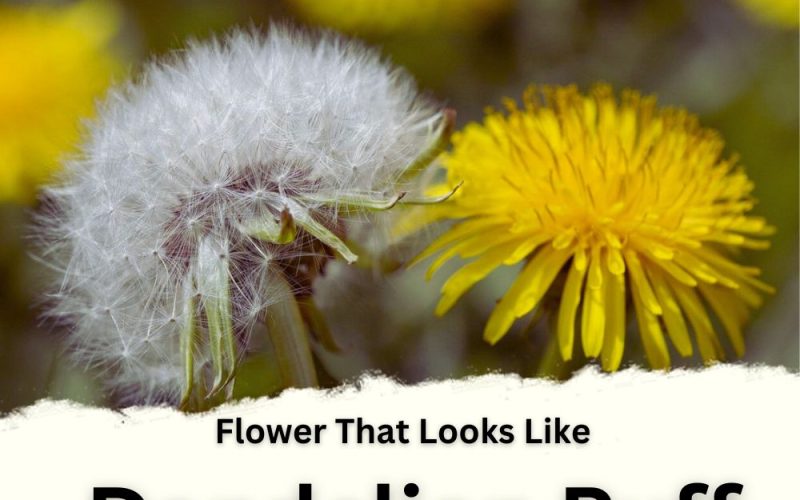If you have seen a flower that looks like a dandelion puff, join me in this article to show you how to identify it with an image and a brief overview of its appearance and habitat.
When I was a kid, I loved to play with puffball flowers of dandelions or other dandelion-like plants. Dandelion is an edible plant, but some of the dandelion-like plants are poisonous. Additionally, some of them can be invasive in certain regions. Therefore, it is essential to be able to distinguish these plants correctly.
In the present article, I can find a list of plants with a flower that looks like a dandelion puff with their names, images, and a brief overview about them that will help you to identify them. Keep reading.
➡ You can hear the audio version of this article too:
List of Plants with Flowers That Look Like Dandelion Puffs
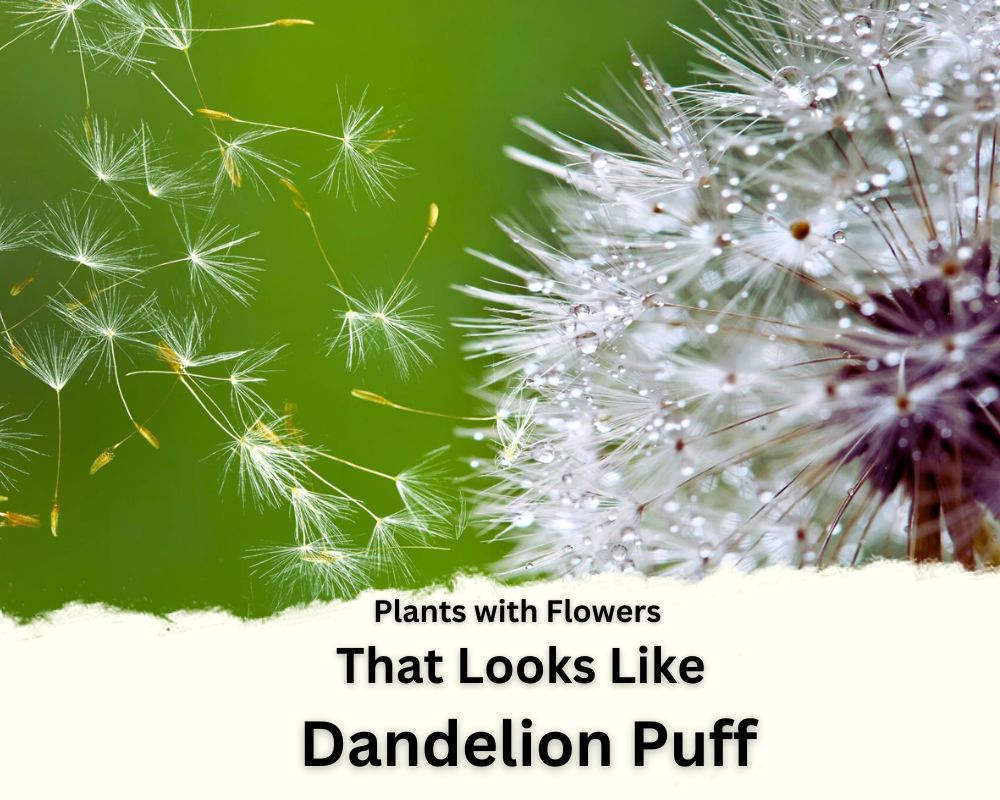
Here, you can see a list of plants whose flowers will turn into a puffball seed head, which looks like a dandelion flower puff. I also provide you with their images and scientific and common names, along with a brief overview of their appearance and habitat.
You can scroll among these plants and find your intended plant. Most of these plants, however, have shiny flowers but are invasive, and if you spot them in your garden, you must consider a practical strategy to control them.
Dandelion with Puff flowers
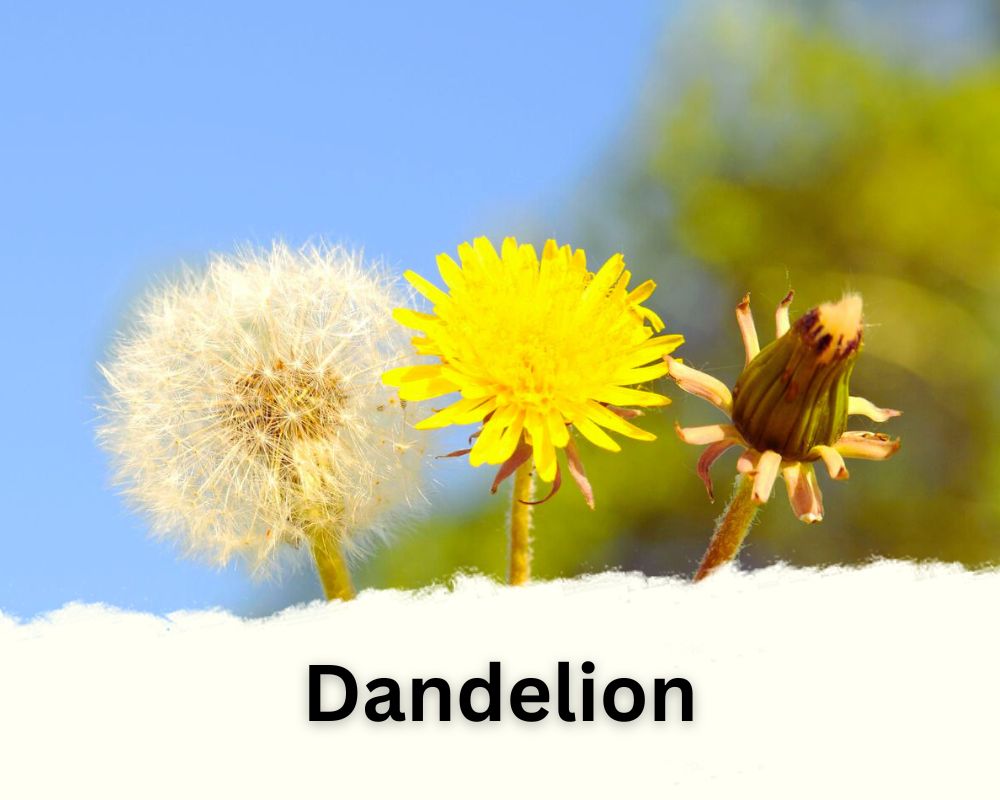
Scientific name: Taraxacum officinale
Other common names: Common Dandelion
Appearance:
Plant Size: Dandelion plants typically range in height from 6 to 12 inches (15 to 30 cm).
Leaves: Deeply toothed, lance-shaped leaves that form a basal rosette.
Flowers: Bright yellow, composite flowers with a central disc and ray petals, forming a round puffball when mature. The dandelion produces a spherical seed head composed of a collection of small, fluffy parachute seeds, which resemble a white, spherical puffball. Dandelion flowers are about 1 to 2 inches (2.5 to 5 cm) in diameter.
Stem: Hollow, smooth, and leafless, with a milky sap.
Flowering time:
Dandelions typically flower in the spring and early summer, although they can often bloom throughout the year in milder climates.
Habitat:
Dandelions are highly adaptable and can be found in a wide range of habitats, including lawns, fields, meadows, and even disturbed urban areas.
Category:
Dandelion is not an invasive plant, and sometimes, due to its beautiful flowers considered an ornamental outdoor plant; however, it’s not common. I love this plant due to it is a cat and dog-safe outdoor plant that lets you have a colourful, pet-friendly garden.
Common Thistle Flower That Looks Like a Dandelion Puff
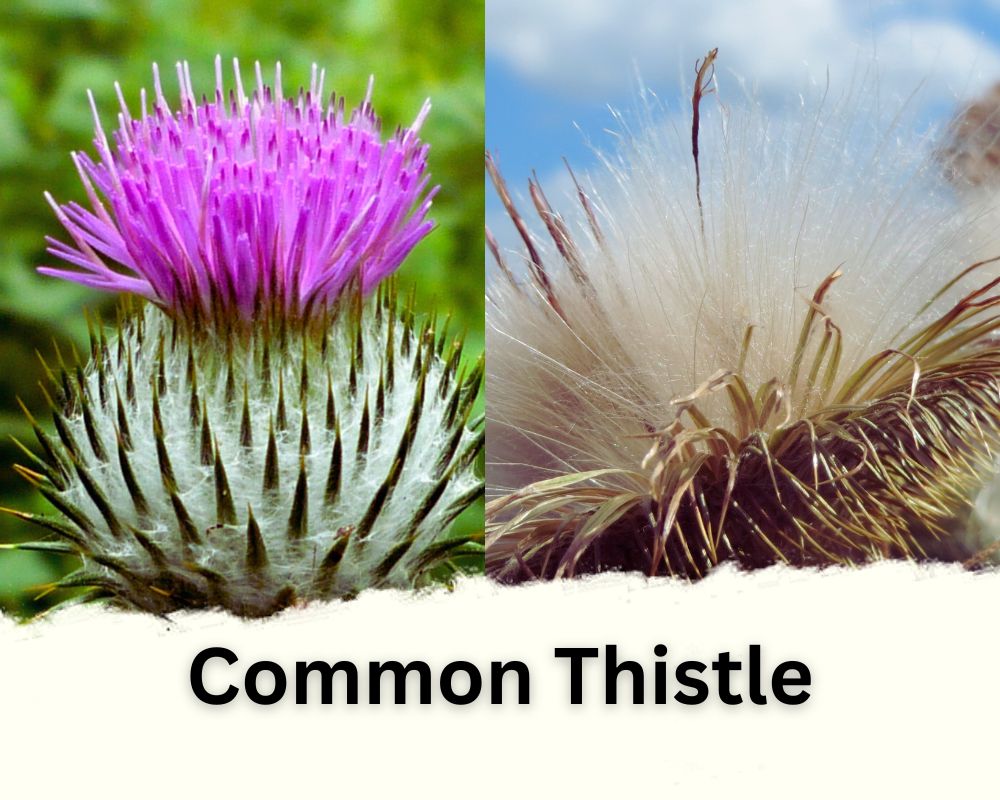
Scientific name: Cirsium vulgare
Other common names: Bull Thistle
Appearance:
Plant Size: Common thistle plants can reach heights of 3 to 6 feet (0.9 to 1.8 meters).
Leaves: Deeply lobed and spiny, often with a waxy coating.
Flowers: Pink to purple thistle-like heads, surrounded by spiny bracts. Common thistle produces seed heads that are spiky, often with a globe-like shape. The seeds have fluffy appendages for wind dispersal. The thistle’s flowers are typically 1 to 2 inches (2.5 to 5 cm) in diameter.
Stem: Tall and erect, covered with spines.
Flowering time:
Flowering Time: Common thistles typically bloom from late spring to late summer, depending on the region.
Habitat:
Common thistle is often found in grasslands, meadows, and disturbed areas. It’s a common weed in pastures and along roadsides.
Category:
Common thistle is considered invasive in many regions, especially in North America. It can outcompete native plants and disrupt ecosystems.
Cat’s Ear Flower That Looks Like a Dandelion Puff
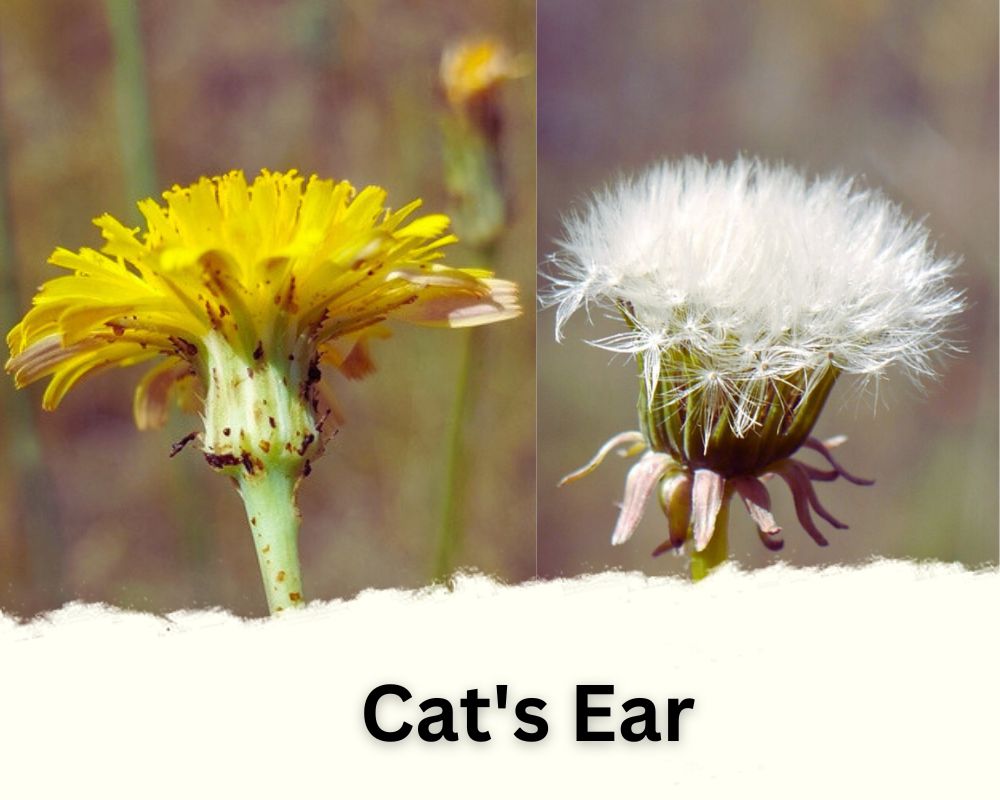
Scientific name: Hypochaeris radicata
Other common names: Spotted Cat’s Ear
Appearance:
Plant Size: Cat’s ear plants are relatively small, growing to heights of 6 to 16 inches (15 to 40 cm).
Leaves: Basal rosette of deeply toothed, elongated leaves with hairy surfaces.
Flowers: Yellow, dandelion-like composite flowers, often with multiple blooms on a single stem. Cat’s ear produces seed heads similar in appearance to dandelions, with spherical puffball-like arrangements for seed dispersal. Cat’s ear flowers are about 1 inch (2.5 cm) in diameter.
Stem: Leafless and hairy, with a milky latex sap. Read my previous post about Cat’s ear vs Dandelion to find more similarities and differences between them.
Flowering time:
It blooms from late spring to early summer and may continue flowering into the fall.
Habitat:
Cat’s ear is commonly found in lawns, grassy areas, and disturbed sites. It prefers open, sunny habitats.
Category:
The cat’s ear has attractive yellow flowers and is sometimes cultivated as an ornamental plant. However, it can become weedy in some locations and become invasive in some regions.
Autumn Hawkbit Flower That Looks Like a Dandelion Puff
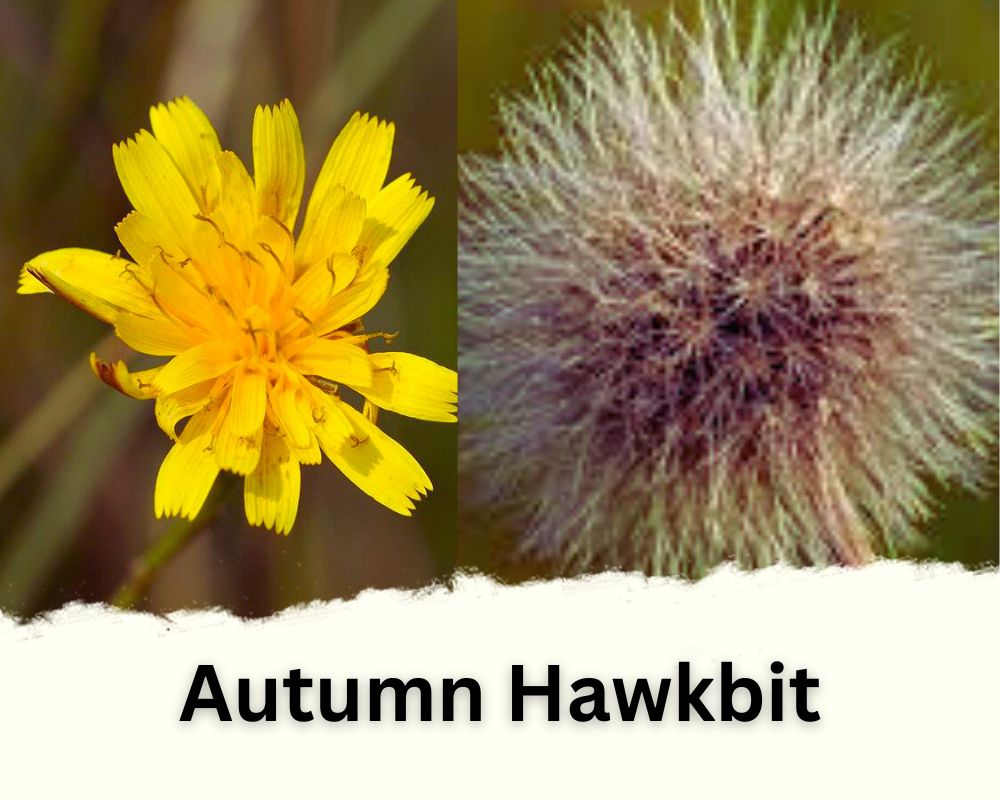
Scientific name: Leontodon autumnalis
Other common names: Fall Dandelion, Common Hawkbit
Appearance:
Plant Size: Autumn hawkbit plants are small, typically reaching heights of 4 to 12 inches (10 to 30 cm).
Leaves: Basal rosette of lance-shaped leaves, often with irregular lobes.
Flowers: Bright yellow dandelion-like flowers with multiple rays on a single stem. Autumn hawkbit produces seed heads that are similar to dandelions, with spherical puffball-like structures for seed dispersal. The flowers are around 1 inch (2.5 cm) in diameter.
Stem: Leafless, hairy, and often with a reddish tint.
Flowering time:
It typically flowers from late spring through summer and into early autumn, as the name suggests.
Habitat:
Autumn hawkbit is often found in grassy areas, meadows, and open fields.
Category:
Autumn hawkbit has charming yellow flowers and is occasionally grown for its ornamental value. It may naturalize in some areas but is not highly invasive.
Common Sowthistle Flower That Looks Like a Dandelion Puff
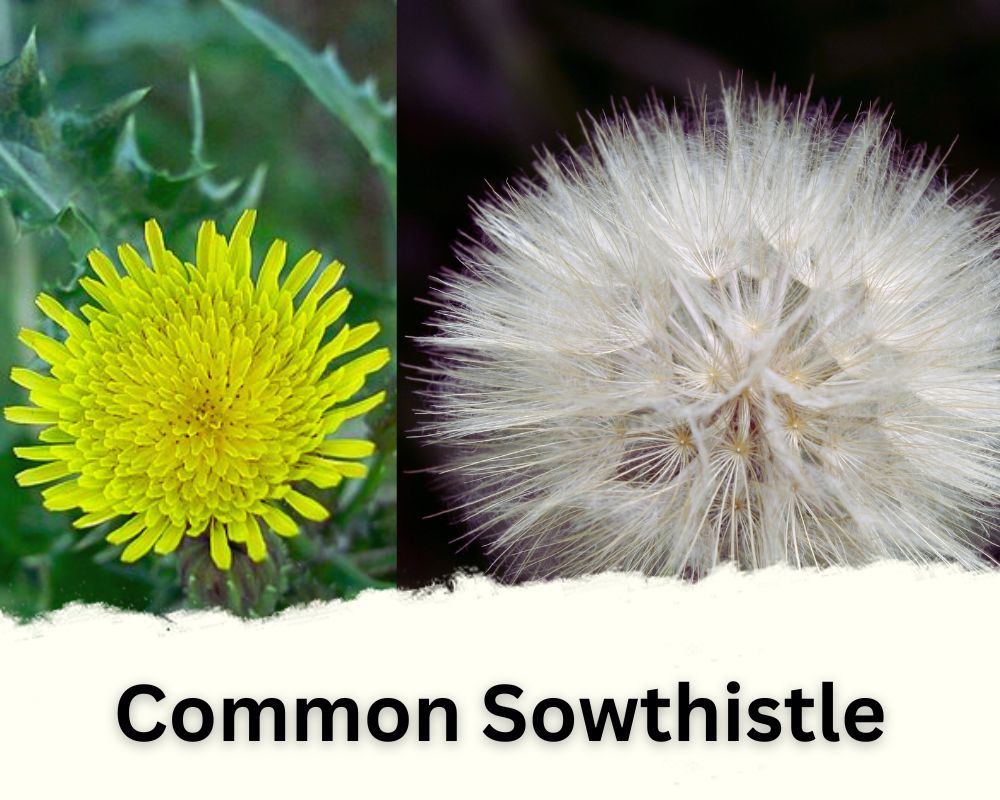
Scientific name: Sonchus oleraceus
Other common names: Smooth Sowthistle
Appearance:
Plant Size: Common sowthistle plants are moderately sized, ranging from 1 to 3 feet (30 to 90 cm) in height. It is one of the tall plants that looks like a dandelion.
Leaves: Smooth, lance-shaped leaves with irregular lobes and spiny margins.
Flowers: Yellow, dandelion-like composite flowers with multiple ray petals. Common sowthistle produces seed heads that resemble dandelion puffballs, with spherical arrangements for seed dispersal. The flowers of common sowthistle are typically 1 to 1.5 inches (2.5 to 3.8 cm) in diameter.
Stem: Smooth, fleshy, and often hollow, with a milky sap.
Flowering time:
It generally blooms from late spring to late summer.
Habitat:
Common sowthistle thrives in a variety of habitats, including gardens, waste areas, and along roadsides.
Category:
Common sowthistle is often regarded as a weedy and potentially invasive species, especially in agricultural settings and disturbed areas.
Common Groundsel Flower That Looks Like a Dandelion Puff
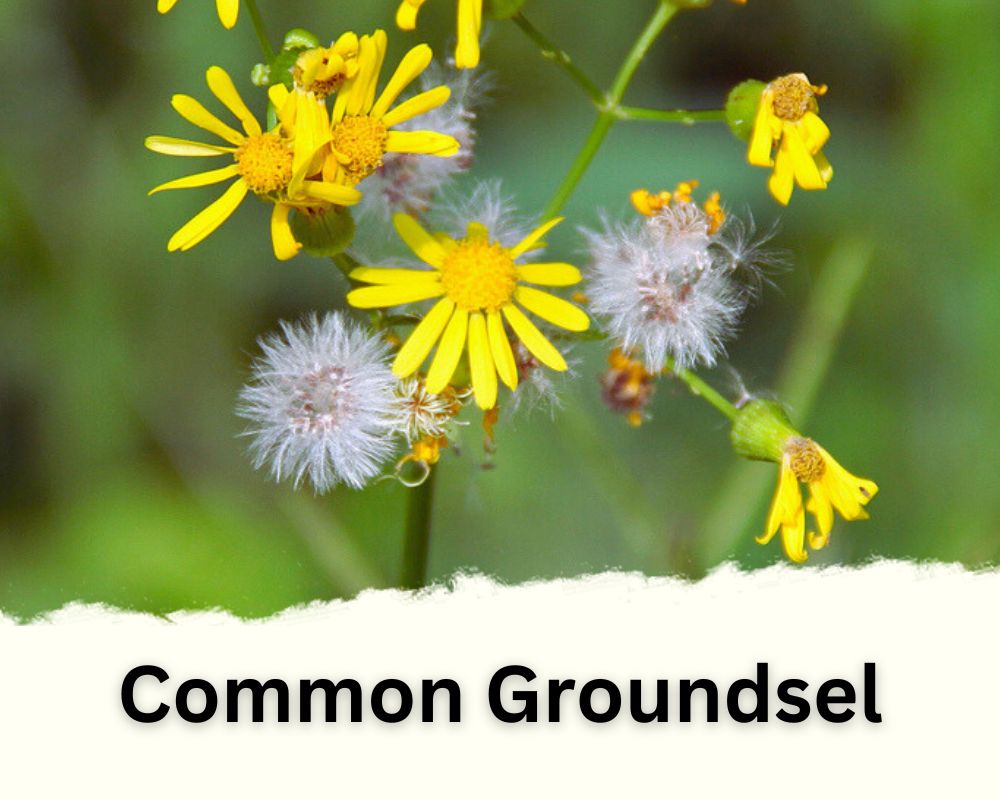
Scientific name: Senecio vulgaris
Other common names: Old-man-in-the-spring
Appearance:
Plant Size: Common groundsel plants are small, usually around 6 to 12 inches (15 to 30 cm) in height.
Leaves: Pinnately lobed, deeply cut, with smooth margins and covered in fine hairs.
Flowers: Small, yellow, daisy-like flowers, forming in clusters. Common groundsel produces small seed heads with fluffy, spherical seeds for wind dispersal, similar to dandelion puffs. The flowers are tiny, measuring less than 0.5 inches (1.3 cm) in diameter.
Stem: Erect, branching, and covered in fine hairs.
Flowering time:
It can flower throughout the year but is most prolific in the spring and early summer.
Habitat:
Common groundsel is commonly found in gardens, waste areas, and disturbed sites.
Category:
Common groundsel is considered a weed and can become invasive in gardens, agricultural fields, and disturbed habitats.
Orange Hawkweed Flower That Looks Like a Dandelion Puff
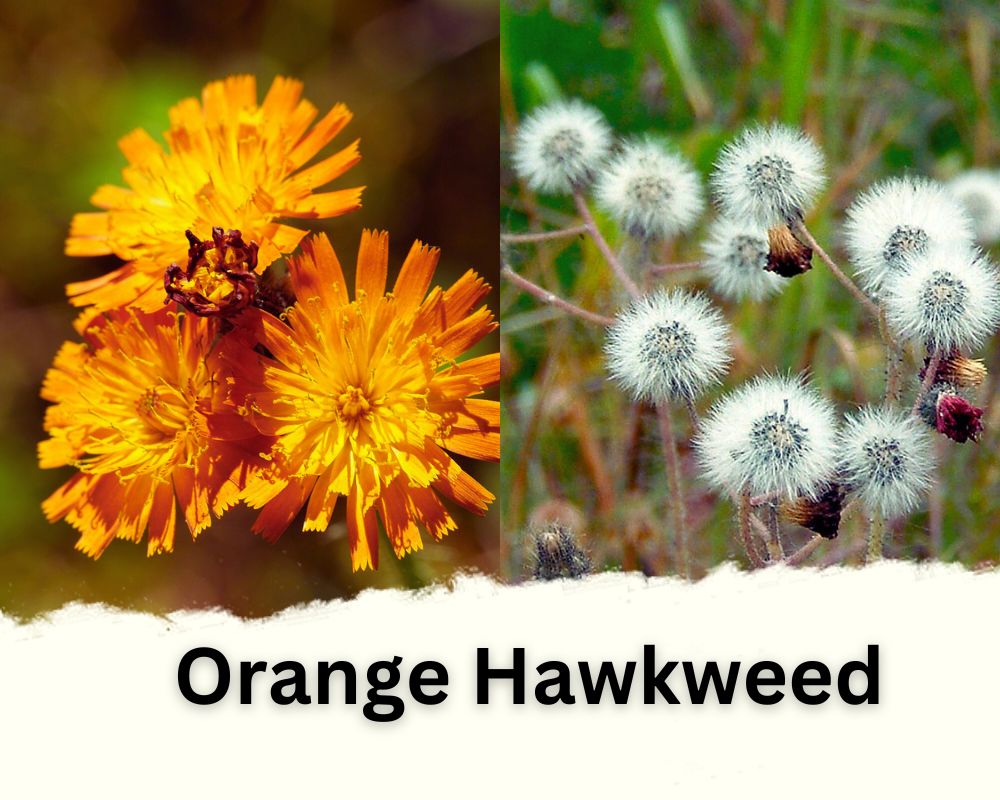
Scientific name: Hieracium aurantiacum
Other common names: Devil’s Paintbrush, King Devil
Appearance:
Plant Size: Orange hawkweed plants typically grow to heights of 8 to 24 inches (20 to 60 cm).
Leaves: Lance-shaped, hairy, and often with a reddish tint.
Flowers: Bright orange to red-orange dandelion-like flowers with multiple rays on a single stem. Orange hawkweed produces seed heads with fluffy, spherical arrangements, similar to dandelion seed heads, for wind dispersal. The flowers are about 1 inch (2.5 cm) in diameter.
Stem: Leafless, hairy, and usually tall.
Flowering time:
It typically blooms in late spring and continues through early summer.
Habitat:
Orange hawkweed prefers open habitats such as meadows, grassy slopes, and roadsides.
Category:
Orange hawkweed is considered invasive in some areas due to its aggressive growth and potential to crowd out native vegetation.
Yellow Salsify Flower That Looks Like a Dandelion Puff
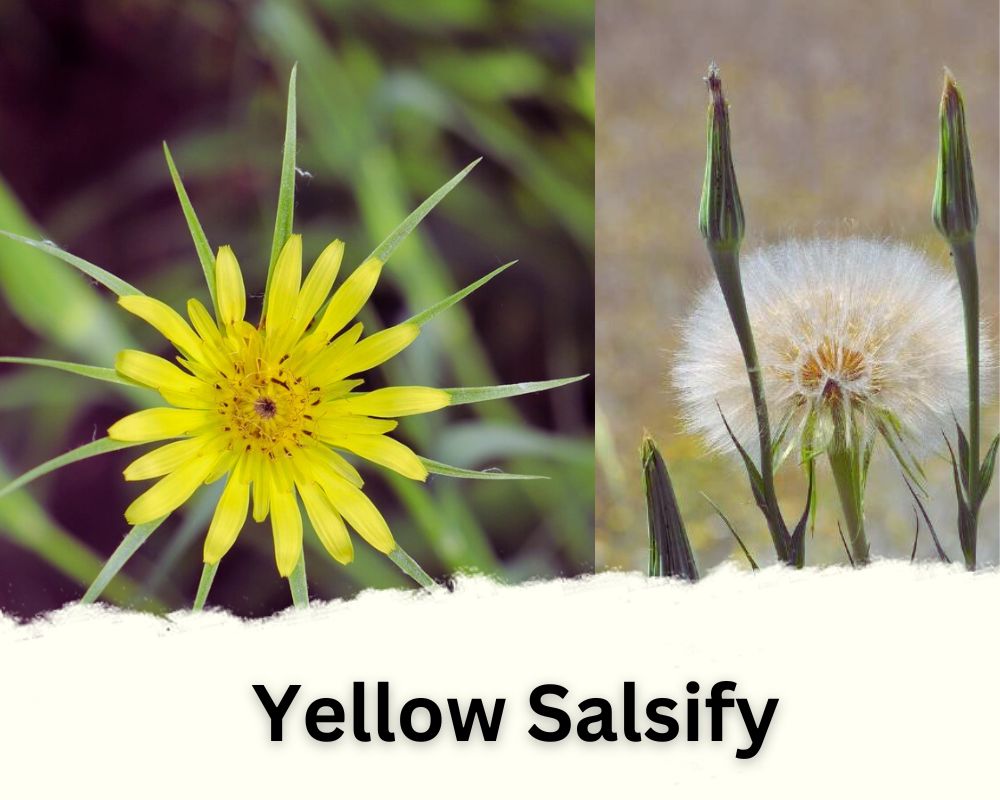
Scientific name: Tragopogon dubius
Other common names: Western Salsify, Goat’s Beard
Appearance:
Plant Size: Yellow salsify plants are moderate in size, reaching heights of 1 to 3 feet (30 to 90 cm).
Leaves: Lance-shaped, grass-like leaves with a glaucous or waxy coating.
Flowers: Bright yellow dandelion-like flowers that close in the afternoon. Yellow salsify produces seed heads with spherical puffball-like structures, similar to dandelions, for seed dispersal. The flowers are approximately 0.5 to 1 inch (1.3 to 2.5 cm) in diameter.
Stem: Upright, leafless, and typically with a milky sap.
Flowering time:
It typically blooms in late spring and early summer.
Habitat:
Yellow salsify is often found in fields, meadows, and along roadsides.
Category:
Yellow salsify is often classified as an invasive plant in certain regions where it can displace native flora.
Smooth Hawksbeard Flower That Looks Like a Dandelion Puff

Scientific name: Crepis capillaris
Other common names: Narrowleaf Hawksbeard, Smooth Hawksbeard
Appearance:
Leaves: Deeply lobed, narrow leaves with a smooth texture.
Flowers: Yellow, dandelion-like composite flowers with multiple ray petals. Smooth hawksbeard produces seed heads that are puffball-like, with spherical arrangements for wind-dispersed seeds, akin to dandelions.
Stem: Leafless, smooth, and often with a reddish tint.
Flowering time:
It typically flowers from late spring to early summer
Habitat:
Smooth Hawksbeard can be found in grassy areas, roadsides, and open fields.
Category:
Smooth hawksbeard is sometimes considered a weed and can become invasive in lawns and fields.
Conclusion
I tried to help you with your intended plant with a flower that looks like a dandelion puff. I provided you with a list of their names and images. You also gained valuable information about their appearance, flowering time, and habitat of these plants.
Did you find your flower that looks like a dandelion puff in the above list? What was its name? Do you know about plant identification tools? Have you ever used them to identify plants? Do you think they work well? Please share your ideas and experiences with our readers below this page.

Elahe Rabiei
Hi, I’m Elaheh. My Academic major is plant protection, and houseplants are my expertise. As a houseplant lover, my house is full of indoor plants and it is my passion to take care of them. Hence, I’m here to share my knowledge and experience about growing healthy houseplants. I am also a plant protection advisor, so feel free to ask me any questions you may have.

